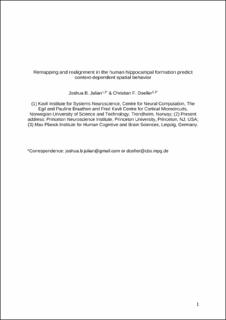| dc.contributor.author | Julian, Joshua B. | |
| dc.contributor.author | Doeller, Christian F. | |
| dc.date.accessioned | 2022-01-06T08:33:10Z | |
| dc.date.available | 2022-01-06T08:33:10Z | |
| dc.date.created | 2021-11-23T10:44:44Z | |
| dc.date.issued | 2021 | |
| dc.identifier.citation | Nature Neuroscience. 2021, 24 (6), 863-872. | en_US |
| dc.identifier.issn | 1097-6256 | |
| dc.identifier.uri | https://hdl.handle.net/11250/2836289 | |
| dc.description.abstract | To guide spatial behavior, the brain must retrieve memories that are appropriately associated with different navigational contexts. Contextual memory might be mediated by cell ensembles in the hippocampal formation that alter their responses to changes in context, processes known as remapping and realignment in the hippocampus and entorhinal cortex, respectively. However, whether remapping and realignment guide context-dependent spatial behavior is unclear. To address this issue, human participants learned object–location associations within two distinct virtual reality environments and subsequently had their memory tested during functional MRI (fMRI) scanning. Entorhinal grid-like representations showed realignment between the two contexts, and coincident changes in fMRI activity patterns consistent with remapping were observed in the hippocampus. Critically, in a third ambiguous context, trial-by-trial remapping and realignment in the hippocampal–entorhinal network predicted context-dependent behavior. These results reveal the hippocampal–entorhinal mechanisms mediating human contextual memory and suggest that the hippocampal formation plays a key role in spatial behavior under uncertainty. | en_US |
| dc.language.iso | eng | en_US |
| dc.publisher | Nature Research | en_US |
| dc.title | Remapping and realignment in the human hippocampal formation predict context-dependent spatial behavior | en_US |
| dc.type | Peer reviewed | en_US |
| dc.type | Journal article | en_US |
| dc.description.version | acceptedVersion | en_US |
| dc.source.pagenumber | 863-872 | en_US |
| dc.source.volume | 24 | en_US |
| dc.source.journal | Nature Neuroscience | en_US |
| dc.source.issue | 6 | en_US |
| dc.identifier.doi | 10.1038/s41593-021-00835-3 | |
| dc.identifier.cristin | 1957645 | |
| dc.description.localcode | This is the authors' accepted manuscript to the article. © 2021 Nature Research | en_US |
| cristin.ispublished | true | |
| cristin.fulltext | postprint | |
| cristin.qualitycode | 2 | |
